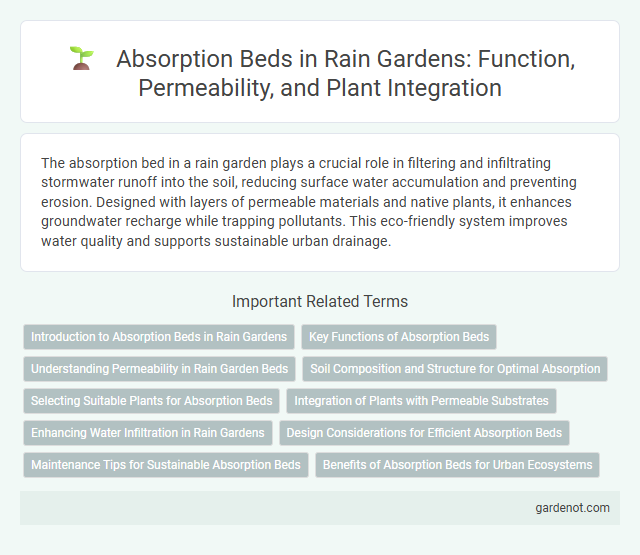The absorption bed in a rain garden plays a crucial role in filtering and infiltrating stormwater runoff into the soil, reducing surface water accumulation and preventing erosion. Designed with layers of permeable materials and native plants, it enhances groundwater recharge while trapping pollutants. This eco-friendly system improves water quality and supports sustainable urban drainage.
Introduction to Absorption Beds in Rain Gardens
Absorption beds in rain gardens are engineered soil layers designed to capture and infiltrate stormwater runoff, reducing surface water accumulation and promoting groundwater recharge. These beds typically consist of a mixture of sandy soil, organic matter, and gravel to enhance permeability and microbial activity for efficient pollutant removal. Strategically placed beneath vegetation, absorption beds mitigate urban flooding while improving water quality through natural filtration processes.
Key Functions of Absorption Beds
Absorption beds play a critical role in rain gardens by facilitating the infiltration and filtration of stormwater runoff through engineered soil media. They enhance groundwater recharge while effectively removing pollutants such as sediments, nutrients, and heavy metals through physical, chemical, and biological processes. These beds optimize water retention and support plant growth, contributing to urban flood mitigation and improved water quality.
Understanding Permeability in Rain Garden Beds
Absorption beds in rain gardens rely heavily on soil permeability to manage stormwater effectively, allowing water to infiltrate and recharge groundwater. High permeability substrates such as sandy loam or amended soils enhance water absorption, preventing surface runoff and reducing flooding risks. Understanding the soil's infiltration rate and porosity is essential for designing absorption beds that maximize water retention and support healthy plant growth.
Soil Composition and Structure for Optimal Absorption
An absorption bed in a rain garden requires a well-balanced soil composition with a mixture of sandy loam, organic matter, and clay to enhance water infiltration and nutrient retention. The soil structure must maintain adequate porosity and permeability to facilitate rapid absorption while preventing waterlogging and allowing beneficial microbial activity. Proper layering and soil aeration improve water distribution and support plant root systems, optimizing overall absorption efficiency in the rain garden.
Selecting Suitable Plants for Absorption Beds
Selecting suitable plants for absorption beds involves prioritizing native, deep-rooted species that enhance soil permeability and maximize water infiltration. Plants such as sedges, rushes, and native grasses with high transpiration rates help prevent waterlogging while supporting local biodiversity. Choosing vegetation adapted to varying moisture levels ensures effective pollutant removal and long-term bed functionality.
Integration of Plants with Permeable Substrates
An absorption bed enhances rain garden efficiency by combining permeable substrates with carefully selected plant species to maximize water infiltration and pollutant removal. Permeable materials like sand, compost, and gravel create a porous medium that supports root growth while facilitating rapid water absorption. The integration of deep-rooted plants and biofiltration species ensures optimal nutrient uptake and soil stabilization within the absorption bed system.
Enhancing Water Infiltration in Rain Gardens
An absorption bed in rain gardens significantly enhances water infiltration by providing a permeable soil medium that captures and filters stormwater runoff. Layers of sand, compost, and native soil within the bed facilitate rapid percolation, reducing surface water runoff and promoting groundwater recharge. This design optimizes the removal of pollutants while maintaining soil moisture balance critical for plant health and ecosystem sustainability.
Design Considerations for Efficient Absorption Beds
An efficient absorption bed design prioritizes soil permeability, slope, and substrate composition to maximize water infiltration and pollutant removal in rain garden systems. Incorporating layered media with adequate porosity, such as sand and organic matter, enhances filtration while preventing clogging and promoting healthy vegetation growth. Proper sizing based on local rainfall data and catchment area ensures optimal water retention capacity and reduces surface runoff effectively.
Maintenance Tips for Sustainable Absorption Beds
Regularly removing accumulated debris and sediment from absorption beds prevents clogging and ensures efficient water infiltration. Inspecting plants and soil for signs of compaction or erosion helps maintain optimal absorption capacity and promotes healthy microbial activity. Applying organic mulch and periodically aerating the soil enhances moisture retention and supports long-term sustainability of absorption beds in rain gardens.
Benefits of Absorption Beds for Urban Ecosystems
Absorption beds enhance urban ecosystems by effectively capturing and filtering stormwater runoff, reducing surface water pollution and decreasing the risk of urban flooding. These systems promote groundwater recharge by allowing water to percolate into the soil, supporting local vegetation and maintaining natural hydrological cycles. Their integration into urban landscapes improves biodiversity, mitigates heat island effects, and contributes to sustainable water management practices.
Absorption bed Infographic

 gardenot.com
gardenot.com